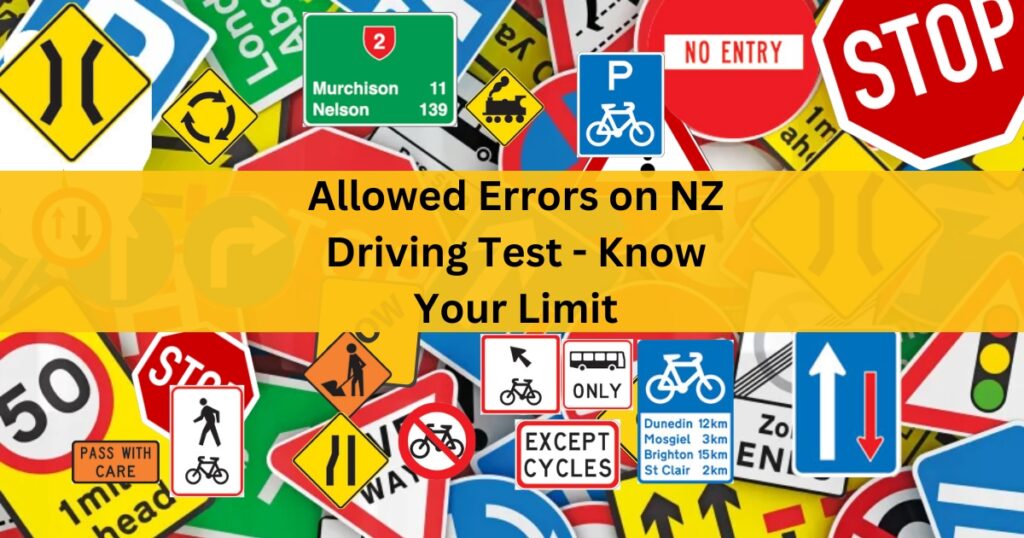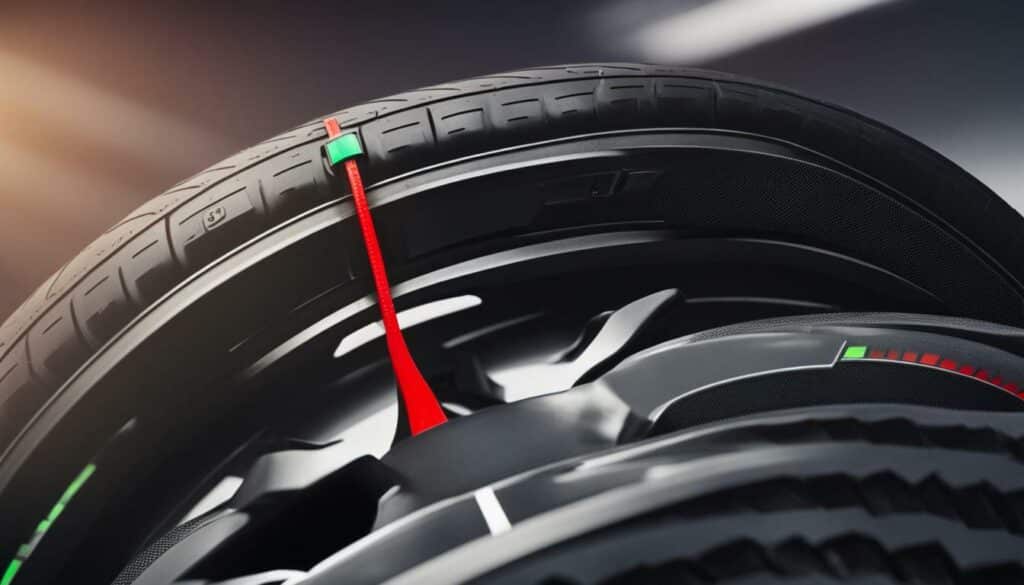When taking the driving test in New Zealand, it’s important to understand the threshold for errors allowed. Factual data from multiple sources reveals that there are specific types of errors that are classified as “Critical Errors” and can result in a fail mark. These include incomplete stops, blocking pedestrian crossings, driving up onto the kerb, driving too slowly or too fast, failing to look, failing to indicate, stalling the vehicle, and other illegal actions. Understanding these errors can help you avoid them and increase your chances of passing the test.
What are Critical Errors on the NZ Driving Test?
Critical errors on the NZ driving test are serious driving mistakes that can impact the outcome of the test. While they may not immediately endanger others or property, they are significant enough to result in a fail mark. Understanding these critical errors is essential to avoid them and increase your chances of passing the driving test in New Zealand.
According to various sources, the following are considered critical errors on the NZ driving test:
- Incomplete stops at stop signs
- Blocking pedestrian crossings
- Driving up onto the kerb
- Driving too slowly or too fast
- Failing to look for other traffic
- Failing to indicate properly
- Stalling the vehicle
- Engaging in other illegal driving actions
These critical errors can have a significant impact on your test results. It is crucial to be aware of them and make a conscious effort to avoid them during the driving test. By practicing safe and responsible driving habits, you can increase your chances of passing the test and obtaining your driver’s license.
| Critical Errors | Consequences |
|---|---|
| Incomplete stops at stop signs | Fail mark |
| Blocking pedestrian crossings | Fail mark |
| Driving up onto the kerb | Fail mark |
| Driving too slowly or too fast | Fail mark |
| Failing to look for other traffic | Fail mark |
| Failing to indicate properly | Fail mark |
| Stalling the vehicle | Fail mark |
| Engaging in other illegal driving actions | Fail mark |
Incomplete Stops: A Critical Error on the NZ Driving Test
One of the critical errors on the NZ driving test is making an incomplete stop at a stop sign. This error is particularly important in the restricted license test, as it leads to a fail mark. In the full license test, it is considered an immediate fail error. An incomplete stop occurs when a driver slows down at a stop sign but does not come to a complete stop. It’s crucial to ensure that you come to a full stop at stop signs during your driving test to avoid this critical error.
During the driving test, examiners pay close attention to a driver’s ability to adhere to the rules of the road, including coming to a complete stop at stop signs. Failing to do so can have severe consequences, as it demonstrates a lack of awareness and can potentially put other road users at risk. In the restricted license test, making an incomplete stop at a stop sign results in a fail mark, meaning the driver will not obtain their restricted license. In the full license test, it is classified as an immediate fail error, resulting in an automatic fail.
Coming to a complete stop at a stop sign is not just an essential part of passing the driving test; it is also a fundamental principle of safe driving. Stop signs are put in place to regulate traffic flow and ensure the safety of all road users. By failing to make a complete stop, drivers increase the risk of accidents, such as collisions with other vehicles or pedestrians who have the right of way. Treating a stop sign as a yield sign or rolling through without fully stopping is not only illegal but can also have serious consequences for everyone on the road.
Therefore, it’s vital for aspiring drivers to understand the significance of making complete stops at stop signs and to prioritize this action during their driving test. By practicing and developing good habits of stopping fully at stop signs, drivers can not only increase their chances of passing the test but also contribute to safer roads for everyone. Remember, failing to make a complete stop at a stop sign is a critical error that can have immediate and lasting consequences.

By avoiding this critical error and maintaining control over the vehicle, you can increase your chances of passing the driving test and earning your driver’s license.
Driving too Slowly: A Critical Error on the NZ Driving Test
During the NZ driving test, it’s crucial to maintain an appropriate speed to ensure the safety of yourself and other road users. Driving too slowly can lead to a critical error and potentially result in a fail mark on both the restricted and full license tests.
According to factual data, if you take longer than 5 seconds to move into a safe gap or consistently drive at least 10 km/h below the speed limit without valid reasons, it will be considered driving too slowly. This error becomes particularly relevant when it holds up the traffic behind you or causes unnecessary stops at pedestrian or school crossings.
As a responsible driver, it’s essential to be aware of your surroundings, including the flow of traffic, and adjust your speed accordingly. It’s important to drive at a pace that is safe and appropriate for the given road conditions, while still maintaining a reasonable speed in relation to the posted speed limit.
To avoid the critical error of driving too slowly on the NZ driving test, always stay mindful of the speed limit, keep up with the flow of traffic, and make sure your driving speed is proportionate to the road conditions. By doing so, you’ll demonstrate your ability to navigate the roads safely and increase your chances of passing the driving test.
Remember, it’s important to strike a balance between driving too fast and driving too slowly. Adapt your speed to the situation at hand, ensuring a safe and enjoyable driving experience for everyone on the road.
Failing to Look: A Critical Error on the NZ Driving Test
Failing to look for other traffic when required is a critical error on the NZ driving test. This includes not checking side mirrors, windows, and blind spots when necessary, as well as not adequately checking for traffic straight ahead. It is particularly important to exercise caution and thorough observation at intersections and railway crossings.
Failing to look properly can have serious consequences and is marked as a critical error in both the restricted and full license tests.
It’s essential to prioritize proper observation during the driving test to ensure the safety of yourself and other road users. By diligently checking your surroundings, you can anticipate potential risks, make informed decisions, and effectively respond to changing traffic situations.
Consequences of Failing to Look on the Driving Test
Failing to look properly during the driving test can result in immediate failure and prevent you from obtaining your desired license. Not only does it indicate a lack of situational awareness, but it also demonstrates a failure to adhere to the fundamental principles of defensive driving.
Additionally, neglecting to look for other traffic can lead to dangerous situations on the road, including collisions, near-misses, and violations of right-of-way rules. These consequences extend beyond the driving test and have the potential to impact your overall driving skills and safety on the road.
Tips to Avoid Failing to Look on the Driving Test
- Develop a habit of regularly checking your mirrors, windows, and blind spots before making any maneuvers.
- Be thorough in your observation when approaching intersections, railway crossings, and merging lanes.
- Stay attentive to the actions of other drivers and anticipate potential hazards.
- Practice defensive driving techniques to enhance your situational awareness on the road.
- Seek guidance from a qualified driving instructor to improve your observation skills during the test.
By diligently practicing these tips and prioritizing proper observation, you can minimize the risk of failing to look and increase your chances of passing the driving test successfully.
Failing to Indicate: A Critical Error on the NZ Driving Test
Proper indication is a crucial aspect of safe driving, and failing to indicate correctly is considered a critical error on the NZ driving test. Not signaling for at least three seconds before turning, changing lanes, pulling away from or into the kerb, crossing the centerline, entering or leaving a roundabout, or stopping next to a parked car for a reverse parallel park can lead to a critical error. It’s important to maintain good signaling habits during the driving test to secure a pass mark on both the restricted and full license tests.
Failure to indicate can have serious consequences on the road. It not only confuses other road users but also increases the risk of accidents, especially when making turns or changing lanes. Indicating well in advance allows other drivers to anticipate your actions and adjust their driving accordingly, promoting safety and smooth traffic flow.
When taking the NZ driving test, remember to use your indicators in a timely manner and make sure they are clear and visible to other road users. Signal at least three seconds before making any maneuver to give other drivers enough time to react. Be mindful of using your signals consistently and predictably, ensuring that they align with your intentions and adhere to traffic rules.
By failing to indicate, you not only commit a critical error but also put yourself and others at risk. The consequences of failing to indicate on the driving test can result in a fail mark, which means you would need to retake the test. Additionally, in real-life scenarios, not indicating properly can lead to accidents, points on your driving record, increased insurance premiums, and potential legal consequences.
Developing good habits and being diligent with your signaling during the driving test will not only increase your chances of passing but also contribute to your overall safety as a driver. Remember, proper indication is an essential part of responsible driving and demonstrating your ability to share the road safely with others.
Consequences of Failing to Indicate on the Driving Test:
- Increased risk of accidents
- Potential fail mark on the driving test
- Requirement to retake the test
- Points on your driving record
- Higher insurance premiums
- Possible legal consequences
Stalling: A Critical Error on the NZ Driving Test
Stalling the vehicle during the NZ driving test is a critical error. Stalling indicates a lack of control over the car and can potentially lead to dangerous situations. This error is particularly relevant for manual transmission vehicles. If you stall the car during the test, it will be marked as a critical error and can result in a fail mark. Both the restricted and full license tests penalize stalling as a critical error.
Stalling during the driving test is a common mistake that many aspiring drivers make. It can happen due to various reasons such as improper clutch control, incorrect gear usage, or nervousness. Regardless of the cause, stalling is considered a serious error that can have consequences on your test results.
When you stall the vehicle, it not only shows a lack of control but also disrupts the flow of traffic. This can potentially put yourself and others at risk. The examiner assesses your ability to handle the vehicle smoothly and safely, and stalling indicates a failure to meet this requirement.
In the restricted license test, stalling is marked as a critical error, meaning it contributes to an immediate fail mark. For the full license test, stalling is also considered a critical error that can lead to a fail mark. Therefore, it is essential to practice your clutch control and gear shifting techniques to minimize the chances of stalling during your driving test.
“Stalling during a driving test can be frustrating and nerve-wracking. It’s crucial to stay calm, regain control, and proceed safely after a stall. Remember, mistakes happen, but it’s important to demonstrate your ability to recover and continue driving safely.”
Conclusion
In conclusion, understanding the errors allowed on the NZ driving test is crucial for success. Critical errors on the test, such as incomplete stops, blocking pedestrian crossings, driving up onto the kerb, driving too slowly or too fast, failing to look, failing to indicate, stalling the vehicle, and engaging in other illegal actions, can result in a fail mark. To increase your chances of passing, it’s essential to be aware of these errors and strive to avoid them during the test.
By prioritizing safe and responsible driving practices, you can ensure a successful outcome on both the restricted and full license tests. It’s important to remember that passing the NZ driving test requires not only the knowledge of traffic rules and regulations but also the ability to demonstrate safe and confident driving skills. Be sure to practice extensively, stay focused, and remain calm during the test to give yourself the best chance of success.
Remember, the NZ driving test is designed to evaluate your readiness to operate a vehicle on the roads. By avoiding critical errors and adhering to road safety guidelines, you can pass the test with flying colors and become a responsible and skilled driver. Good luck on your journey to obtaining your driver’s license!
FAQ
How many errors are allowed on the driving test in NZ?
There is a threshold for errors allowed on the driving test in NZ. Certain errors, known as “Critical Errors,” can result in a fail mark. It is important to understand and avoid these critical errors to increase your chances of passing the test.
What are Critical Errors on the NZ Driving Test?
Critical errors on the NZ driving test refer to serious driving errors that can impact the outcome of the test. They include incomplete stops, blocking pedestrian crossings, driving up onto the kerb, driving too slowly or too fast, failing to look for other traffic, failing to indicate properly, stalling the vehicle, and engaging in other illegal driving actions.
Incomplete Stops: A Critical Error on the NZ Driving Test
Making an incomplete stop at a stop sign is considered a critical error on the NZ driving test. It is important to ensure that you come to a full stop at stop signs during your driving test to avoid this error.
Blocking Pedestrian Crossings: A Critical Error on the NZ Driving Test
Blocking a pedestrian crossing without a valid reason is considered a critical error on the NZ driving test. It is important to prioritize the safety of pedestrians and give them the right of way before proceeding.
Driving Up onto the Kerb: A Critical Error on the NZ Driving Test
Driving up onto the kerb is considered a critical error on the NZ driving test. This includes driving one wheel or more up onto the kerb or bumping it hard, demonstrating a lack of control over the vehicle.
Driving too Slowly: A Critical Error on the NZ Driving Test
Driving too slowly can lead to a critical error on the NZ driving test. If you take longer than 5 seconds to move into a safe gap or drive at least 10 km/h below the speed limit without valid reasons, it will be considered driving too slowly.
Failing to Look: A Critical Error on the NZ Driving Test
Failing to look for other traffic when required is a critical error on the NZ driving test. This includes not checking side mirrors, windows, blind spots, and not adequately checking for traffic straight ahead.
Failing to Indicate: A Critical Error on the NZ Driving Test
Failing to indicate correctly is considered a critical error on the NZ driving test. This includes not signaling for at least three seconds before turning, changing lanes, pulling away from or into the kerb, crossing the centerline, entering or leaving a roundabout, or stopping next to a parked car for a reverse parallel park.
Stalling: A Critical Error on the NZ Driving Test
Stalling the vehicle during the NZ driving test is a critical error. It demonstrates a lack of control over the car and can potentially lead to dangerous situations, especially in manual transmission vehicles.
How to pass the NZ driving test by avoiding critical errors?
To pass the NZ driving test and avoid critical errors, it is important to understand and practice proper driving techniques, such as making complete stops, being aware of and giving priority to pedestrians, maintaining control of the vehicle, driving at an appropriate speed, checking for other traffic, indicating properly, and avoiding stalling the vehicle. Following these guidelines will increase your chances of passing the test.
Can I still pass the driving test if I make a minor error?
While making minor errors during the driving test is common, it is important to avoid critical errors as they can result in a fail mark. It is best to strive for safe and responsible driving practices, minimizing both minor and critical errors, in order to pass the test successfully.




